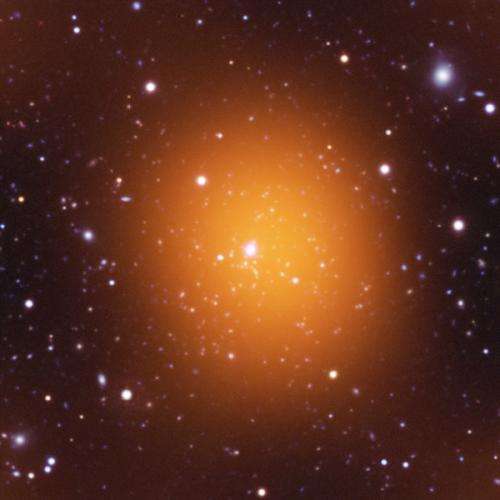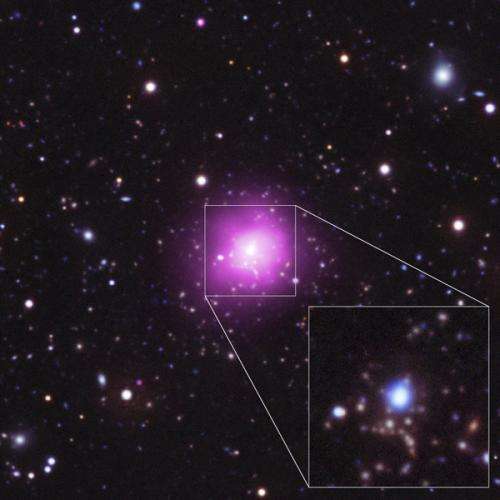Microwave (orange), optical (red, green, blue) and ultraviolet (blue) image of Phoenix Cluster. (Credit: NASA/CXO Press Office)
(Phys.org) -- Astronomers have found an extraordinary galaxy cluster -- one of the largest objects in the Universe -- that is breaking several important cosmic records. Observations of this cluster, known as the Phoenix Cluster, with NASA's Chandra X-ray Observatory, the NSF’s South Pole Telescope and eight other world-class observatories, may force astronomers to rethink how these colossal structures, and the galaxies that inhabit them, evolve.
Stars are forming in the Phoenix Cluster at the highest rate ever observed for the middle of a galaxy cluster. The object is also the most powerful producer of X-rays of any known cluster, and among the most massive of clusters. The data also suggest that the rate of hot gas cooling in the central regions of the cluster is the largest ever observed.
This galaxy cluster has been dubbed the "Phoenix Cluster" because it is located in the constellation of the Phoenix, and because of its remarkable properties. The cluster is located about 5.7 billion light years from Earth.
"The mythology of the Phoenix -- a bird rising from the dead -- is a great way to describe this revived object," said Michael McDonald, a Hubble Fellow in the Kavli Institute for Astrophysics and Space Research at the Massachusetts Institute of Technology and the lead author of a paper appearing in the August 16th issue of the journal Nature. "While galaxies at the center of most clusters may have been dormant for billions of years, the central galaxy in this cluster seems to have come back to life with a new burst of star formation."
This animation shows how large numbers of stars form in the Phoenix Cluster. It begins by showing several galaxies in the cluster and hot gas (in red). This hot gas contains more normal matter than all of the galaxies in the cluster combined, and can only be detected with X-ray telescopes like Chandra. The camera then flies in towards the large elliptical galaxy at the center of the cluster. The hot gas near this galaxy is giving off copious amounts of X-rays and cooling quickly over time, as shown by the change to a blue color. This cooling causes gas to flow inwards along filaments and form huge numbers of stars when it continues to cool. Credit: NASA/CXC/A. Hobart
Like other galaxy clusters, Phoenix contains a vast reservoir of hot gas -- containing more normal matter than all of the galaxies in the cluster combined -- that can only be detected with X-ray telescopes like Chandra. The prevailing wisdom had once been that this hot gas should cool over time and sink to the galaxy at the center of the cluster, forming huge numbers of stars.
However, most galaxy clusters have formed very few stars over the last few billion years. Astronomers think that the supermassive black hole in the central galaxy of clusters pumps energy into the system, preventing cooling of gas from causing a burst of star formation.
The famous Perseus Cluster is an example of a black hole bellowing out energy and preventing the gas from cooling to form stars at a high rate. Repeated outbursts from the black hole in the center of Perseus, in the form of powerful jets, created giant cavities and produced sound waves with an incredibly deep B-flat note 57 octaves below middle C.
"We thought that these very deep sounds might be found in galaxy clusters everywhere," said co-author Ryan Foley, a Clay Fellow at the Harvard-Smithsonian Center for Astrophysics in Cambridge, Mass. "The Phoenix Cluster is showing us this is not the case - or at least there are times the music stops. Jets from the giant black hole at the center of a cluster are apparently not powerful enough to prevent the cluster gas from cooling.”
With its black hole not producing powerful enough jets, the center of the Phoenix Cluster is buzzing with stars that are forming about 20 times faster than in the Perseus cluster. This rate is the highest seen in the center of a galaxy cluster but not the highest seen anywhere in the Universe. However, the overall record-holding galaxies, located outside clusters, have rates only about twice as high.
Optical/UV/X-ray composite image of the Phoenix cluster, with a pull-out of the central region. (Credit: NASA/CXO Press Office)
The frenetic pace of star birth and cooling of gas in Phoenix are causing both the galaxy and the black hole to add mass very quickly -- an important phase that the researchers predict will be relatively short-lived.
"The galaxy and its black hole are undergoing unsustainable growth," said co-author Bradford Benson, a Kavli Fellow in the Kavli Institute for Cosmological Physics at the University of Chicago. "This growth spurt can't last longer than about a hundred million years, otherwise the galaxy and black hole would become much bigger than their counterparts in the nearby Universe."
Remarkably, the Phoenix Cluster and its central galaxy and supermassive black hole are already among the most massive known objects of their type.
Because of their tremendous size, galaxy clusters are crucial objects for studying cosmology and galaxy evolution and so finding one with such extreme properties like the Phoenix Cluster is important.
"This spectacular star burst is a very significant discovery because it suggests we have to rethink how the massive galaxies in the centers of clusters grow," said Martin Rees of Cambridge University, who was not involved with the study. "The cooling of hot gas might be a much more important source of stars than previously thought."
The Phoenix Cluster was originally detected by the National Science Foundation's South Pole Telescope, and later was observed in optical light by the Gemini Observatory in Chile as well as the Blanco 4-meter and Magellan telescopes, also in Chile. The hot gas and its rate of cooling were estimated from Chandra data. To measure the star formation rate in the Phoenix Cluster, several space-based telescopes were used including NASA's WISE and GALEX, and ESA's Herschel.
Journal information: Nature
Provided by NASA
























